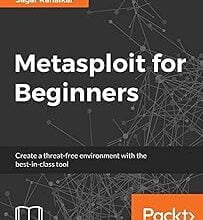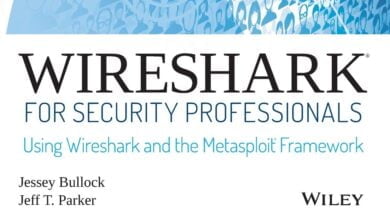Practical Web Penetration Testing: Secure web applications using Burp Suite, Nmap, Metasploit, and More
by Gus Khawaja

Rating: 4.7/5
Greetings to the ambitious guardians of the digital realm! Let me introduce you to Gus Khawaja’s magnum opus: Practical Web Penetration Testing: Secure web applications using Burp Suite, Nmap, Metasploit, and More. A book that has managed to create ripples in the cybersecurity community, boasting a commendable rating of 4.7/5. Allow me to embark on this journey of unraveling the pearls hidden within its pages.
A Holistic, Hands-on Approach: Khawaja doesn’t just skim the surface. Instead, he dives deep into the tangible aspects of cybersecurity, guiding the reader through each process with the precision of a master craftsman. The title is not mere hyperbole – the book truly is a masterclass on tools like Burp Suite, Nmap, and Metasploit. In today’s world, where web application vulnerabilities are rampant, the book’s meticulously detailed walkthrough on leveraging Burp Suite is nothing short of a revelation.
Building a Fortified Mindset: While techniques and tools are integral, what sets this book apart is Khawaja’s emphasis on nurturing a fortified cybersecurity mindset. His mantra that “security isn’t a product, but a process” is an astute observation that echoes throughout the chapters. Such a perspective is invaluable, emphasizing that true security is about proactive vigilance and adaptation, rather than a one-off task.
From Theory to Action – Real-World Scenarios: No book on ethical hacking can truly resonate unless it demonstrates real-life vulnerabilities and their exploitations. Khawaja delivers in spades. His simulation of a SQL injection, followed by the masterful use of Metasploit to exploit this vulnerability, offers an insightful peek into the psyche of potential attackers. Such real-world scenarios serve as a bridge, transforming theoretical knowledge into actionable insights – a transition that every budding ethical hacker aspires to achieve.
Critiques – Every Rose has its Thorn: Khawaja’s work is an arsenal of information, but it’s not without its flaws. The book could benefit from deeper dives into the foundational principles underpinning the various tools and methodologies. After all, a true master not only knows the ‘how’ but understands the ‘why’ behind each move. Furthermore, as web technologies continue to evolve at a rapid pace, a deeper discourse on emerging vulnerabilities associated with modern web architectures would have further elevated the book’s stature.
Audience Spectrum – From Enthusiasts to Veterans: Advanced beginners and competent learners will find Practical Web Penetration Testing to be a goldmine. It not only demystifies complex tools but embeds in them the ethical considerations vital for responsible hacking. While the proficient and the experts might crave a deeper theoretical dive, the plethora of real-life simulations and walkthroughs offer them an arena to test and refine their skills.
The Quintessential Tools of Modern Web Penetration Testing
Burp Suite – The Web App Warrior’s Weapon: Gus Khawaja’s emphasis on Burp Suite is both timely and apt. Originating from the genius of Dafydd Stuttard, Burp Suite emerged as a one-stop solution for web application security. Its evolution over the years has been monumental, growing from a simple intercepting proxy to a comprehensive suite offering functionalities like scanning, spidering, and brute-forcing.
In the realm of the book, Khawaja demonstrates the power of the Burp Suite by highlighting its relevance in various testing scenarios. The tool’s ability to seamlessly capture, analyze, and modify web traffic makes it an indispensable tool for beginners eager to understand the intricacies of HTTP communication. On the other hand, experts appreciate the advanced features like Intruder and Repeater that enable custom attack scenarios and fine-grained payloads.
A case in point: A real-world case study from a renowned bug bounty program showcased how a vulnerability, seemingly benign during manual inspection, was ingeniously exploited using Burp Suite’s advanced functionalities, leading to a critical data breach. Khawaja’s book beautifully delineates such instances, reinforcing the tool’s pertinence in modern web security.
Nmap – The Silent Reconnaissance Expert: Nmap, standing for Network Mapper, is not just a tool; it’s a legacy. Fyodor’s creation in 1997, Nmap’s journey from a simple network scanner to a multifaceted utility boasting features like OS detection and scriptable interactions is awe-inspiring.
In “Practical Web Penetration Testing,” the significance of Nmap’s prowess in silent reconnaissance is evident. While beginners find solace in its intuitive command-line interface and basic scanning functionalities, experts in bug bounty hunting often resort to its scripting engine, enabling them to craft unique scans tailored for specific vulnerabilities.
A fascinating case study Khawaja refers to is the discovery of an unprotected database on a prominent e-commerce site. While the misconfiguration was the site’s oversight, it was Nmap’s advanced scanning technique that unveiled this critical vulnerability, leading to a hefty bug bounty reward.
Metasploit – The Swiss Army Knife of Exploitation: Metasploit’s inception in 2003 by H.D. Moore marked a revolution in the domain of vulnerability exploitation. Over time, it has become the go-to framework for penetration testers globally, housing an array of payloads, exploits, and post-exploitation modules.
Khawaja’s affinity for Metasploit in his book is evident. The framework’s modular architecture allows beginners to grasp the fundamentals of exploitation, from simple buffer overflows to intricate RCEs (Remote Code Executions). Seasoned bug hunters, on the other hand, relish the flexibility it offers, allowing them to customize and even create new modules catering to specific vulnerabilities.
An illuminating case study in the book recounts a bug hunter’s journey, where a seemingly patched service was compromised using an obscure Metasploit module, emphasizing the framework’s depth and the continual learning it demands.
Integration – Where the Real Magic Happens
The beauty of the tools Khawaja discusses isn’t just in their standalone capabilities but in their potential for integration. By stringing them together, penetration testers can simulate complex attack scenarios, mirroring real-world threats more accurately.
Burp Suite and Nmap – Crafting the Perfect Attack Vector: Consider a scenario where a bug hunter, using Nmap, identifies a web application running a vulnerable version of software. Post identification, Burp Suite can be employed to craft the exact attack vector, whether it’s a crafted payload to exploit a vulnerability or a subtle manipulation to reveal sensitive information. Khawaja exemplifies such integration by recounting a real-world case where an outdated web server disclosed server internals, paving the way for a targeted attack.
Metasploit and Everything – The Ultimate Power Play: The adaptability of Metasploit is legendary. Once vulnerabilities are unearthed using tools like Nmap or potential entry points marked by Burp Suite, Metasploit serves as the artillery, ready to fire. Be it a pre-crafted exploit or a custom payload; Metasploit’s integration with other tools makes exploitation a seamless process. An episode Khawaja narrates involves using Metasploit in tandem with a vulnerability scanner, automating the exploitation process, and demonstrating how efficiency, combined with precision, is often the key to successful penetration testing.
Delving into the Modules
Burp Suite’s Intruder: Among the crown jewels of Burp Suite is the ‘Intruder’ module. This utility, meant for automating custom attacks against web applications, can be used for tasks ranging from simple password brute force attacks to more advanced data extraction and enumeration. Khawaja provides a riveting walkthrough, displaying how an insecure login mechanism of a renowned online portal was exploited using Intruder, leading to unauthorized access.
Nmap’s Scripting Engine (NSE): One of Nmap’s most powerful features, the Scripting Engine, facilitates the execution of simple scripts to gather more advanced details about targets or even discover vulnerabilities. Khawaja delves into an instance where NSE scripts were employed to unearth a misconfigured service, revealing sensitive information.
Metasploit’s Meterpreter: This payload, once injected into the compromised system, provides a powerful command line interface, allowing operations from uploading and downloading files to capturing screenshots or even escalating privileges. A captivating case study in Khawaja’s book describes how Meterpreter was stealthily used to maintain persistence in a compromised web application, undetected, yielding valuable data over time.
Spotlight on Complementary Tools
OWASP ZAP: Khawaja doesn’t overlook the Open Web Application Security Project’s (OWASP) ZAP, a free security tool tailor-made for finding vulnerabilities in web applications. While it holds similarities with Burp Suite, its unique functionalities, especially for those on a tight budget, make it an excellent complementary tool.
Wireshark: This renowned network protocol analyzer proves invaluable in capturing and analyzing traffic. Its relevance, especially when used alongside tools like Nmap or Burp Suite, is emphasized through various scenarios in the book, showcasing how deep packet inspection can lead to the discovery of obscure vulnerabilities.
Wrapping up the Toolbox Discussion: While these tools, with their rich history and evolving capabilities, stand as individual pillars of web penetration testing, Khawaja’s genius lies in demonstrating their orchestration. His book illuminates how these tools, when wielded in tandem, can unveil vulnerabilities that might go unnoticed when used in isolation.
Khawaja’s Practical Web Penetration Testing serves as more than a mere guide to tools; it’s a testament to the holistic approach required in modern web security. Tools, while pivotal, are just the start. It’s the intricate dance of integration, understanding the depth of modules, and the inclusion of complementary utilities that make a penetration tester versatile and, ultimately, successful. Whether a neophyte or a seasoned expert, the book is a clarion call: know your tools, but more importantly, know how they intertwine.




